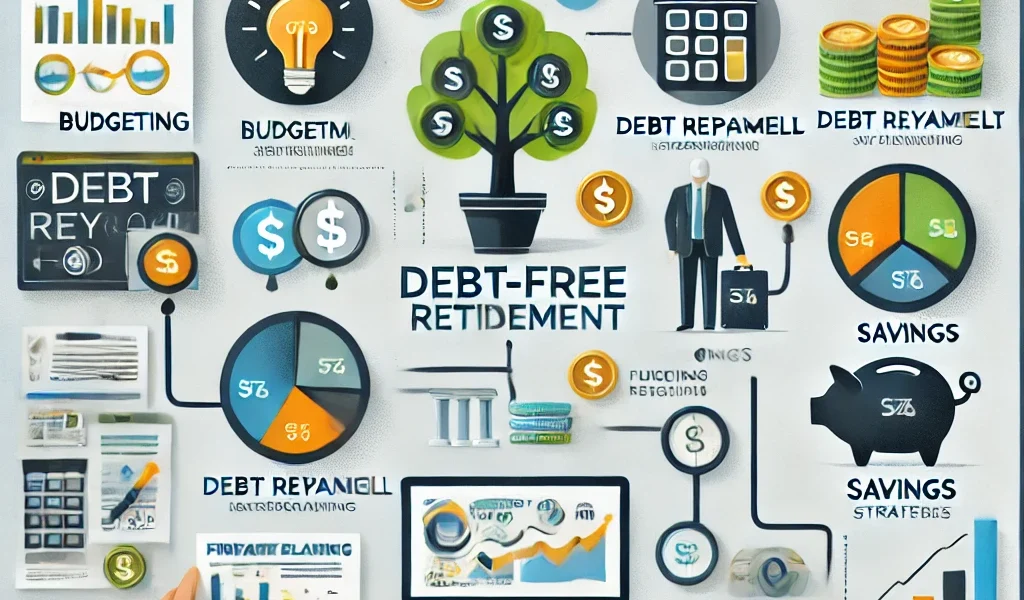Introduction
Retirement should be a time of relaxation and financial security. However, debt can significantly impact your ability to enjoy a stress-free retirement. Ensuring a debt-free lifestyle after retirement requires careful planning, disciplined saving, and smart financial decisions. This guide explores effective strategies to eliminate debt before retirement and maintain financial independence.
Why a Debt-Free Retirement Matters
Carrying debt into retirement can limit your financial freedom and put strain on your fixed income. Here’s why you should aim for a debt-free retirement:
- Lower Financial Stress: Without debt, you can enjoy your golden years without financial worries.
- Better Cash Flow: More of your retirement income can go toward living expenses and leisure rather than debt repayments.
- Increased Security: Debt-free retirees are less vulnerable to financial crises and unexpected expenses.
- More Investment Opportunities: Without monthly debt obligations, you can invest more in income-generating assets.
Steps to Achieve a Debt-Free Retirement
1. Assess Your Current Debt Situation
Before planning your retirement, evaluate your current financial obligations. Categorize your debts into:
- Mortgage Debt – Home loans or second mortgages.
- Credit Card Debt – High-interest revolving credit.
- Student Loans – Personal or co-signed educational loans.
- Car Loans – Auto financing payments.
- Medical Bills – Outstanding healthcare costs.
Create a spreadsheet listing each debt, interest rate, and monthly payment. This will help prioritize repayment strategies.
2. Create a Debt Payoff Plan
Eliminating debt before retirement requires a structured repayment strategy. Consider these methods:
- The Snowball Method: Pay off the smallest debt first while making minimum payments on larger debts. This builds motivation as you eliminate debts one by one.
- The Avalanche Method: Focus on paying off the highest-interest debt first to save money in the long run.
- Consolidation or Refinancing: If possible, consolidate high-interest debts into a lower-interest loan for easier repayment.
3. Increase Your Retirement Savings
While paying off debt, continue contributing to retirement accounts. Here’s how to balance both:
- Allocate a portion of your income toward extra debt payments while still saving for retirement.
- Take advantage of employer-matching contributions in retirement plans like 401(k) or provident funds.
- Utilize tax-advantaged accounts such as IRAs or Roth IRAs to grow savings efficiently.
4. Cut Unnecessary Expenses
Minimizing expenses helps free up funds for debt repayment and savings. Review your monthly spending and:
- Reduce discretionary spending on luxury items, dining out, and subscriptions.
- Downsize to a smaller home or relocate to a lower-cost area.
- Use budgeting apps to track spending and identify wasteful expenses.
5. Boost Your Income Before Retirement
Increasing your income can accelerate debt repayment and boost your retirement savings. Consider:
- Working a few more years to maximize pension benefits.
- Taking up a side job, freelancing, or consulting to generate additional income.
- Renting out an extra property or investing in passive income sources.
6. Pay Off Your Mortgage Early
If you own a home, consider making extra payments to eliminate your mortgage before retirement. Options include:
- Making biweekly payments instead of monthly ones.
- Applying windfalls (bonuses, tax refunds) toward mortgage principal.
- Refinancing to a shorter loan term with lower interest rates.
7. Avoid New Debt
Once you’re close to retirement, avoid taking on new financial obligations. Be cautious with:
- Large purchases requiring financing (e.g., luxury cars, vacation homes).
- Cosigning loans for family members, which can increase financial risk.
- Using credit cards without a clear repayment plan.
8. Plan for Healthcare Costs
Medical expenses can become a financial burden in retirement. To prevent debt:
- Invest in long-term care insurance or Medicare supplement plans.
- Build a dedicated health savings account (HSA) for medical emergencies.
- Choose healthcare plans that align with your expected needs and budget.
9. Build an Emergency Fund
An emergency fund helps cover unexpected expenses without relying on credit. Aim for:
- At least 6–12 months’ worth of living expenses in a liquid account.
- Separating this fund from your regular retirement savings.
10. Seek Professional Financial Advice
A financial planner can help create a customized debt-reduction strategy. They can:
- Assess your financial situation and suggest investment options.
- Help optimize retirement savings while managing debt.
- Provide guidance on tax-efficient withdrawal strategies.
Maintaining a Debt-Free Lifestyle in Retirement
Once you’ve eliminated debt, maintaining financial stability is crucial. Here’s how:
- Stick to a Budget: Monitor spending and adjust as needed to avoid financial strain.
- Live Within Your Means: Base your expenses on your fixed income rather than depleting savings.
- Continue Investing Wisely: Maintain a diversified investment portfolio to generate passive income.
- Stay Financially Disciplined: Avoid impulse purchases and unnecessary debt accumulation.
Conclusion
Ensuring a debt-free retirement requires early planning, disciplined saving, and smart financial decisions. By eliminating outstanding debts, increasing savings, and maintaining a sustainable lifestyle, you can enjoy a financially secure and stress-free retirement. Start today to pave the way for a debt-free future!




